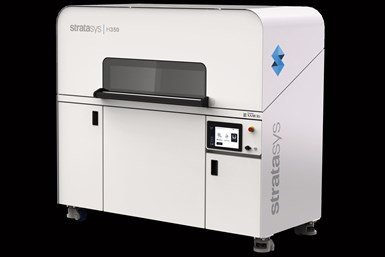Stratasys H350 3D Printer Delivers Production-Grade End-Use Parts
The Stratasys H350 3D printer is powered by Selective Absorption Fusion (SAF) technology to deliver production-level throughput for end-use parts.

Stratasys H350 3D printer
The Stratasys H350 3D printer, the first 3D printer in Stratasys’ new H Series Production Platform, is powered by Selective Absorption Fusion (SAF) technology to deliver production-level throughput for end-use parts. The machine was developed to help accelerate the shift from traditional to additive manufacturing for low- to mid-volume production applications underserved by traditional manufacturing methods.
The printer is designed to give manufacturers production consistency, a competitive and predictable cost per part, and complete control for the production of thousands of parts. The H350 printer even includes about a dozen different parts 3D printed with SAF technology.
The printer is well-suited for the manufacture of quality finished, end-use products; molds and robust load-bearing parts; and functionally enhanced parts. Applications include end-use parts such as covers, connectors, hinges, cable holders, electronics housings and ducting, enabling companies to grow their business through volume production with consistent end-use functional parts.
Stratasys is using certified third-party materials for the H Series systems for traditional volume production of end-use parts. The initial material is Stratasys High Yield PA11, which is an ecofriendly, 100% biobased plastic made from sustainably grown castor beans. It’s an engineering grade polymer that offers higher ductility, impact and fatigue resistance, making it suitable for a wide range of industrial applications.
The industrial-grade SAF technology includes long-lasting piezoelectric printheads, patented Big-Wave powder deposition and unique thermal management to provides consistency throughout the build volume. The one pass print-and-fuse process, 12% nesting density and minimized consumables enables users to achieve production-level throughput. It also enables users to achieve fine feature detailing and uniformity with a single High Absorption Fluid (HAF).
The H350 printer has been in beta testing since early 2021, reliably fulfilling orders for both large parts as well as up to several hundred smaller parts, with consistent parts throughout the build volume, the company says.
Related Content
-
Beehive Industries Is Going Big on Small-Scale Engines Made Through Additive Manufacturing
Backed by decades of experience in both aviation and additive, the company is now laser-focused on a single goal: developing, proving and scaling production of engines providing 5,000 lbs of thrust or less.
-
3D Printed Titanium Replaces Aluminum for Unmanned Aircraft Wing Splice: The Cool Parts Show #72
Rapid Plasma Deposition produces the near-net-shape preform for a newly designed wing splice for remotely piloted aircraft from General Atomics. The Cool Parts Show visits Norsk Titanium, where this part is made.
-
Video: 5" Diameter Navy Artillery Rounds Made Through Robot Directed Energy Deposition (DED) Instead of Forging
Big Metal Additive conceives additive manufacturing production factory making hundreds of Navy projectile housings per day.













